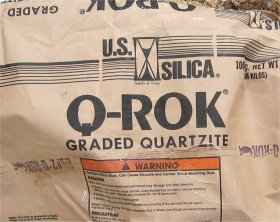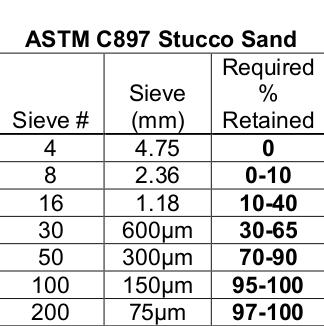Graded sand for plaster
ASTM C 897, “Standard Specification for Aggregate for Job-Mixed Portland Cement-Based Plasters” ASTM C 926, “ Standard Specification for Application of Portland Cement-Based Plaster"
This sandblasting sand is graded
from medium (about 1-2 mm) down to a very fine
powder. The varied grits, or different particle size
adds increased strength and crack resistance
to stucco.
When used in a cement basecoat for high strength applications such as stucco
floors or cement boats, the various grits can
quadruple the compressive strength of Portland
cement mortar.
The reason is that the smaller grains fill
in the voids when the mortar is packed down.
This is what we usually use in our stucco finish
coat.

Q-ROK is graded quartzite,
which means crushed quartz or crushed
white sandstone. Sand like Q-ROK is used in
stucco finishes, but
the grading is different. Q-ROK comes in 3
grades, #1, or fine; #2, or
medium and #3, coarse. Fine powder is packaged as
silica fines.
The main difference is that number 3 is all the
same size (about 3 mm.) Number two is all
medium, and number 1 is all fine.
When used as a stucco finish, different
grades are usually mixed together to vary the
size for improved strength and appearance.

What this means in human readable terms:
Silica sand (usually crushed quartz or sandstone)
is passed through various screen sizes and
measured as to the percentage of what size the grains
are.
Everything above 4.75mm is thrown away. The sand is then graded from less than 2.36mm (coarse or #
3)down to a fine powder of 75 micrometers (µm) or
75 thousandths of a millimeter.
This chart is completely ambiguous if you do the math, but the idea is that the sand is graded from
coarse
down to fine powder.
Also, since the sand is irregularly shaped, larger
width particles can pass through the sieves.